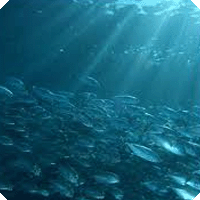Research Focus |
|
昆虫体内的光合作用-蚜虫可能具有光合作用系统 2013-01-28 21:52:14 浏览次数:8443 | |
| 昆虫体内的光合作用-蚜虫可能具有光合作用系统 来源:仪方生物 自然界的蚜虫生物学异乎寻常:他们具有一出生就怀孕的能力,并且雄性蚜虫有时候缺少嘴而导致在他们交配后不久就死亡。在这些特异的表型之外,最新的发布的研究结果显示他们能够捕获太阳光并且利用这些能量用于代谢过程。 蚜虫具有区别于其他昆虫类的合成类胡萝卜素功能。许多生物借助于这些色素来完成多种功能例如维持健康免疫系统和合成维生素类,但是所以其他动物必须通过饮食来获取。法国索非亚农业生物科技研究院的昆虫学家Alain Robichon和他的同事提出在蚜虫类中这些色素能够吸收太阳能量并转化为体内能量生成的细胞结构中。  Photosynthesis-like process found in insects Aphids may have a rudimentary sunlight-harvesting system. The biology of aphids is bizarre: they can be born pregnant and males sometimes lack mouths, causing them to die not long after mating. In an addition to their list of anomalies, work published this week indicates that they may also capture sunlight and use the energy for metabolic purposes. Aphids are unique among insects in their ability to synthesize pigments called carotenoids. Many creatures rely on these pigments for a variety of functions, such as maintaining a healthy immune system and making certain vitamins, but all other animals must obtain them through their diet. Entomologist Alain Robichon at the Sophia Agrobiotech Institute in Sophia Antipolis, France, and his colleagues suggest that, in aphids, these pigments can absorb energy from the Sun and transfer it to the cellular machinery involved in energy production. Although unprecedented in animals, this capability is common in other kingdoms. Plants and algae, as well as certain fungi and bacteria, also synthesize carotenoids, and in all of these organisms the pigments form part of the photosynthetic machinery. Home-made harvesters Taking their cue from the 2010 finding2 that the high levels of carotenoids found in aphids are homegrown, Robichon and his team set out to investigate why the insects make such metabolically expensive chemicals. Carotenoids are responsible for aphid pigmentation, and an aphid's colour determines the kind of predators that can see it. The body colour of Robichon's lab aphids is affected by environmental conditions, with the cold favouring green aphids, optimal conditions resulting in orange ones and white ones appearing when the population is large and faced with limited resources. When the researchers measured the aphids’ levels of ATP — the ‘currency’ of energy transfer in all living things — the results were striking. Green aphids, which contain high levels of carotenoids, make significantly more ATP than do white ones, which are almost devoid of these pigments. Moreover, ATP production rose when the orange insects — which contain an intermediate amount of carotenoids — were placed in the light, and fell when they were moved into the dark. The researchers went on to crush the orange aphids and purify their carotenoids, demonstrating that it was these extracts that could absorb light and pass this energy on. One of the authors, Maria Capovilla, another entomologist at the Sophia Institute, insists that much more work is needed before scientists can be sure that aphids truly photosynthesize, but the findings certainly throw up that possibility. The way that carotene molecules are arranged in the animals adds weight to that hypothesis. The pigments form a layer between 0–40 micrometres deep under the insect's cuticle, putting them in the perfect position to capture the Sun's light. Nancy Moran, an insect geneticist at Yale University in West Haven, Connecticut, who was responsible for the original discovery that aphids have the genes for carotenoid production, points out that there are many unanswered questions. “Energy production seems to be the least of an aphid's problems — their diet is loaded with excessive sugar, most of which they cannot use,” she says. And that begs the question of why aphids would need to photosynthesize. But Capovilla speculates that a battery-like back-up might help them in times of environmental stress, such as when they are migrating to a new host plant. Nature: doi:10.1038/nature.2012.11214 |
